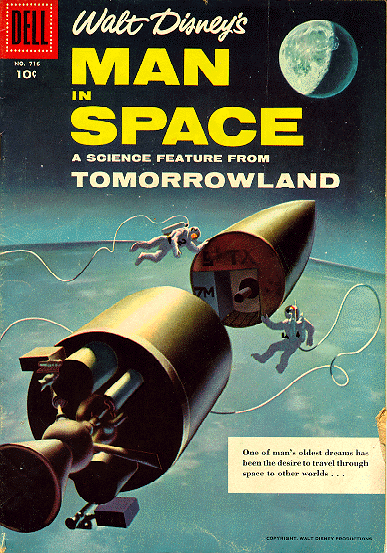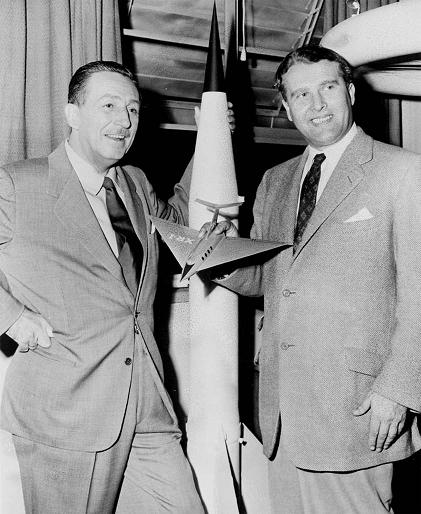
As part of this month’s observation of Walt Disney’s space age visions, guest blogger Jeff Pepper provides an overview of Walt’s pioneering series of Space Exploration programs. “Man in Space” will have a rare public screening in the state-of-the-art digital theatre at The Walt Disney Family Museum on Saturday, July 23 at 3:00PM. Internationally-respected Disney Historian Jim Korkis (The Vault of Walt) will be hosting the presentation and providing insight into this groundbreaking television programming. Tickets are available at the Reception and Member Service Desk at our museum, or online at www.waltdisney.org.
That the episode “Man in Space” that aired on March 9, 1955 on the Disneylandtelevision program is significant on so many levels. It began a Disney “futurism franchise” that would extend from television into movie theaters, print media, and ultimately form the very basis of Tomorrowland at Disneyland, and later Walt Disney World as well.
Unlike the majority of Disney-produced entertainment from the same time period, “Man in Space” has not aged well beyond being an interesting time-capsule look at the genesis of America’s fascination with, and the ultimate execution of a program of space exploration. Co-written, produced and directed by Ward Kimball, the program would be the first of numerous episodes under the Tomorrowland brand, helmed by Kimball, that focused on space travel and other science-related topics. A shortened version of the show was released theatrically in 1956, and was even nominated for an Academy Award®.
Of the Tomorrowland episodes, Kimball once recalled, “Walt had the vision and curiosity to let me make those pictures, but he had to! He had Tomorrowland in the park. He had Fantasyland, True-Life Adventureland, Frontierland, but he had no old material that he could put together on Tomorrowland for the television. It all had to be created for from nothing, and I got that job.”
Even with the infusion, at times, of trademark Ward Kimball wackiness, “Man in Space” rarely rises above a series of dry lectures by then notable scientific luminaries Willy Ley, Heinz Haber and Wernher von Braun. One particularly bizarre set of contrasting elements is the Haber dissertation on the physical impact of space travel on human beings. While Haber drones on about the problems of weightlessness, the accompanying animated sequence comically portrays a cigar-smoking, martini-drinking astronaut-in-training, experiencing the very trials that Haber is expounding on so seriously.
 At times it can feel a long road to the program’s final dramatic, and visually dynamic realization of an orbital space mission. Despite, or even perhaps due to the sequence’s limited animation and high-contrast images, it is a shining example of the 1950s futurism that became a distinct part of post-war popular culture.
At times it can feel a long road to the program’s final dramatic, and visually dynamic realization of an orbital space mission. Despite, or even perhaps due to the sequence’s limited animation and high-contrast images, it is a shining example of the 1950s futurism that became a distinct part of post-war popular culture.
Like the television-theme park hybird that Disneyland essentially was in 1955, Tomorrowland the place and Tomorrowland the program seemed to experience simultaneous development, clearly drawing from the same sources of inspiration. Up until the 1990s re-imagining of the Anaheim, Tokyo, and Florida Tomorrowlands into “futures that never were,” (patterned after Discoveryland in Disneyland Paris that debuted in 1992), the prior visions of these Magic Kingdom areas were always for the most part rooted in “Man in Space” and the subsequent space- and science-themed episodes of the Disney television show. As late as 1993, Walt Disney World guests were still experiencing an incarnation of those early television shows in the form of Mission to Mars, an evolved version of Disneyland’s original Flight to the Moon attraction.
Perhaps the most interesting footnote about “Man in Space” is the largely unnoticed impact it had on the development of the U.S. space program. President Eisenhower was so impressed with the program that he requested a print of the film to screen for high-ranking Pentagon officials, which was evidently instrumental in kick starting the country’s space initiatives. Many 20th Century historians would no doubt bristle over giving acknowledgment to a Hollywood cartoon maker for in anyway potentially inspiring mankind’s initial conquests of space.
Years after the program originally aired, Kimball received a phone call from Wernher von Braun. “When we landed on the moon, he called me long distance and said, ‘Well, Ward, they’re following our script!’ Actually, all his calculations were right on the button.”
Jeffrey Pepper is a journalist and historian who writes extensively about popular culture, and most especially about Walt Disney and the history of The Walt Disney Company. He is the author of the popular Disney-related website 2719 Hyperion. He is also the author ofBoom-Pop!, a website devoted to 20th century pop culture, and the creator, author and designer of Hawkins Strongbox, a faux-history website with a distinct steampunk flavor.
2719 Hyperion presents informative and enjoyable content relating to any and all types of Disney entertainment. 2719 Hyperion is dedicated to the memory of Walt Disney and explores and celebrates his legacy of creativity and innovation that very much originated within the walls of the Walt Disney Studios complex, once located at 2719 Hyperion Avenue near Hollywood, California.
Images above: 1) Dell Comic Book Cover ©Disney. 2) Walt and rocket scientist, aerospace engineer, space architect—and Disney consultant—Wernher von Braun. © Disney.
